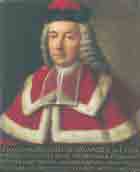Francois Boissier de Sauvages de la Croix
1706-1767
 Francois Boissier de Sauvages was a 18th century botanist and professor of medicine at the University of Montpellier, in France. He first published his work in a small book Nouvelles classes de maladies (1731). Included in his medical classification were fevers, inflammations, spasms, breathing disturbances, weaknesses, pains, and dementias. He organized dementias into four types, those of extracerebral origin, those involving disturbances of instinctual and emotional life, those involving intellectual life, and those caused by irregular eccentricities and follies.
Francois Boissier de Sauvages was a 18th century botanist and professor of medicine at the University of Montpellier, in France. He first published his work in a small book Nouvelles classes de maladies (1731). Included in his medical classification were fevers, inflammations, spasms, breathing disturbances, weaknesses, pains, and dementias. He organized dementias into four types, those of extracerebral origin, those involving disturbances of instinctual and emotional life, those involving intellectual life, and those caused by irregular eccentricities and follies.
In 1771, de Sauvages completed a fuller, three-volume version of his taxonomy called Nosologie methodique (Systematic nosology). In it he distinguished 2400 diseases which he divided into ten classes. Each class was further divided into orders and genera. His classification of mental diseases made up the eighth class and was also part of order 5 in the sixth class. Many of de Sauvages categories of mental diseases had already been worked out by Linnaeus. For example, both Linnaeus and de Sauvages considered love sickness to be a type of mental illness. In this book, De Sauvages divided melancholia into a number of species, including religious, extravagant, vagabonding, enthusiastic, and sorrowful.
In his 1771 book, de Sauvages described psellisum or speech disorders in terms of its subtypes. Included were:
- psellismus ischnophonia, or stuttering: difficulty of moving the velum, the uvula and the root of the tongue.
- psellismus rhotacismus: problem with the r sound
- psellismus lambdacismus: problem with l sound
- psellismus traulotes: indistinctness, (lisping?)
- psellismus balbuties: problem with labials,
- psellismus mogilalia: problem with labials (another kind?)
- psellismus metallicus: a speech problem caused by metallic poisons
- psellismus iotacismus: a problem with guttural sounds
- psellismus nastas: nasality
- psellismus lagostomatum: cleft lip and palate
- psellismus a ranula: a speech problem caused by tumors (Hunt, 1870, p. 41, Hunt 1882, p. 186 passim)
Writings about de Sauvages
Hunt, James, (1870). Stammering and stuttering: their nature and treatment. (6th edition) London: Longmans, Green and Co. Retrieved on June 27, 2010 from http://books.google.com/books?id=H8-TkfYqR_AC&pg=PA41&dq=Sauvages+psellismus+mogilalia&hl=en&ei=mvQnTMqKDIG78ga9q7zEDw&sa=X&oi=book_result&ct=result&resnum=1&ved=0CCcQ6AEwAA#v=onepage&q=Sauvages%20psellismus%20mogilalia&f=false
Eggleston, William G. (1882) Translations from the French: Stammering, balbuties, psellismus, North Carolina Medical Journal, 10, 186-190.
